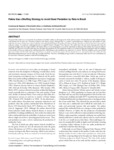Use este identificador para citar ou linkar para este item:
http://www.alice.cnptia.embrapa.br/alice/handle/doc/875543Registro completo de metadados
| Campo DC | Valor | Idioma |
|---|---|---|
| dc.contributor.author | CAMILO-ALVES, C. de S. e P. | pt_BR |
| dc.contributor.author | MOURAO, G. de M. | pt_BR |
| dc.date.accessioned | 2011-04-10T11:11:11Z | pt_BR |
| dc.date.available | 2011-04-10T11:11:11Z | pt_BR |
| dc.date.created | 2011-02-03 | pt_BR |
| dc.date.issued | 2010 | pt_BR |
| dc.identifier.citation | Biotrópica, v. 42, n.2, p. 167-173, 2010. | pt_BR |
| dc.identifier.uri | http://www.alice.cnptia.embrapa.br/alice/handle/doc/875543 | pt_BR |
| dc.description | The goal of this study was to ascertain why the production of variable seediness is advantageous for Attalea phalerata palms. Our hypothesis was that variation reduces seed predation by the spiny rats Thrichomys pachyurus and Clyomys laticeps. Although there is a positive correlation between endocarp size and number of seeds, endocarps sometimes contain more or fewer seeds than expected; palms bluff about the number of seed per endocarp. Therefore, rats do not know how many seeds an endocarp contains. To model rats? predating behavior, we applied Charnov?s Marginal Value Theorem. The model shows that rats attack endocarps only when the energy gain is higher than the energy available in the habitat. Hence, it is not advantageous to eat all the seeds inside an endocarp. This explains why 45 percent of forest endocarps and 35 percent of savanna endocarps were still viable after predation. We then applied the model to two simulated endocarp populations with less variability in the number of seeds per endocarp size and determined that viable diaspores after predation were reduced to 15 percent. With less variability, palms cannot bluff about the number of seeds inside endocarps and predators can predict accurately how many seeds they should try to eat. Uncertainty about the number of seeds diminished predation but gave selective advantage to multiseeded fruits. Therefore, the bluffing strategy would be evolutionarily stable only if it were counterbalanced by other forces. Otherwise, predators would win the bluffing game. | pt_BR |
| dc.language.iso | eng | eng |
| dc.rights | openAccess | eng |
| dc.subject | Clyomys laticeps | pt_BR |
| dc.subject | Marginal value theorem | pt_BR |
| dc.subject | Multiseeded fruits | pt_BR |
| dc.subject | Predator prey interaction | pt_BR |
| dc.subject | Thrichomys pachyurus | pt_BR |
| dc.title | Palms use a bluffing strategy to avoid seed predation by rats in Brazil. | pt_BR |
| dc.type | Artigo de periódico | pt_BR |
| dc.date.updated | 2017-07-21T11:11:11Z | pt_BR |
| dc.subject.nalthesaurus | Attalea phalerata | pt_BR |
| dc.subject.nalthesaurus | Pantanal | pt_BR |
| riaa.ainfo.id | 875543 | pt_BR |
| riaa.ainfo.lastupdate | 2017-07-21 | pt_BR |
| dc.contributor.institution | CONSTANÇA DE SAMPAIO E PAIVA CAMILO-ALVES; GUILHERME DE MIRANDA MOURAO, CPAP. | pt_BR |
| Aparece nas coleções: | Artigo em periódico indexado (CPAP)  | |
Arquivos associados a este item:
| Arquivo | Descrição | Tamanho | Formato | |
|---|---|---|---|---|
| palmsuseabluffingstrategy.pdf | 179,71 kB | Adobe PDF |  Visualizar/Abrir |









